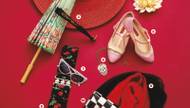Every piece of clothing has a story, but few people can recognize and interpret it like Karan Feder.
Before moving to Las Vegas in 2004, the fashion historian served as a costume designer in Hollywood, working in television, film and theater, and with the flamboyant and fabulous Bob Mackie, who has styled everyone from Cher to Diana Ross and Miley Cyrus. Since those days, she has consulted and curated for several local museums, including the historic Liberace Museum, David Copperfield’s Museum and Library of the Conjuring Arts, the Mob Museum and the Nevada State Museum, where she helped acquire more than 8,000 pieces from the Tropicana’s famed Les Folies Bergere, Vegas’ longest running show.
Feder has also filled several books with her bottomless knowledge, the latest being 2023’s Barbie Takes the Catwalk, A Style Icon’s History in Fashion, wherein she connects 40 years of Barbie fashion to designers’ inspirations of the time. That project is also a touring exhibition that will land at New York’s Museum of Arts and Design this fall.
You didn’t really tap into the legacy of Barbie until you started this project. What made you want to start it in the first place?
I was working at the Nevada State Museum with their costume and textile collection and one of my colleagues there, David Porcello, had been collecting vintage fashion for his whole life. I learned that part of what he collected was also Barbie fashion—not Barbie dolls, but Barbie fashion. I thought that was such an interesting spin on the Barbie collector. When COVID hit, and I was no longer working at the State Museum, I thought, I really want to explore this Barbie fashion thing. There have been other exhibitions and other books about Barbie dolls. So our spin on this was let’s try to prove that Barbie doll fashion does reflect culture. When you look back you can in fact see the evolution of Barbie doll fashion does parallel that of American fashion during that 40-year span of time.
Why did you choose to cover just that first 40 years?
After about 2000, the internet became really prevalent in life. And when that happens, it basically opens the door to a vast amount of visual inspiration. At that point in time, I believe that the culture designers, those folks that were telling us what to wear, really lost control of the fashion narrative. Even if you’re not a fashion historian, you can think about the 1960s and there’s a visual identity. There’s a visual identity that the ’70s, the ’80s, the ’90s have. By the time you get to 2000, it’s really hard. There are so many different identity groups that define the decades going forward that it’s harder to pinpoint what’s going on.
When I started this project, I thought well, this is going to be really fun because I’ll get to comb through Mattel’s archives, and they’ll have evidence that tells me these particular designers were looking at these particular runways at these particular times. None of that exists. For me to pick something out of the void and say this is what a designer was looking at, at a certain moment of time post-2000 becomes more of a creativity project than an actual primary source exercise. That’s where I wanted to stop.
In the early 2000s, Barbie starts to realize she has a problem with her physical form and who she’s representing. That’s when this slippery slope starts to happen, and the Barbie dolls’ clothing becomes less important, and her physical forms, the various skin tones and hair tones and ethnic backgrounds become much more important than Barbie’s clothing. It becomes really a different toy then going forward.
It was amazing timing for you to have written the book and then the Barbie movie craze happened last year. Did you hear from the people at Mattel at all about this?
It first started with the Barbie exhibition, and then once we were halfway through the exhibition, I realized that all of my ideas were not going to be able to fit in this exhibit. That’s when the book started. This is 2020. The exhibition and the book are licensed. We run all of the narrative through Mattel and Mattel curates it as they see fit. We knew that there was a Barbie movie in the works. We knew it was a Warner Brothers picture. We knew that Margot [Robbie] and Ryan [Gosling] were the stars. And we knew that Greta [Gerwig] was directing. That’s about all we knew. We, in 2020, were working in our own silo on our fashion exhibition. Then the Barbie movie team were working in their own silo at exactly the same time. We never collaborated. We really had no idea what anyone was doing. The exhibition predated the movie.
You started out in costume design. What was it about fashion preservation and history that made you want to make the leap over?
One of the first places I visited here, when it was still open, was the Liberace Museum. I was not aware of Liberace. I hadn’t followed his career. I wasn’t really well in tune with the costumes. He just sort of had escaped my radar. So when I landed here, I discovered Liberace, and I realized that that genre of costume was its own unique beast that Las Vegas has been promoting for decades. There are examples of it around the world, in other cabaret settings, but it really is unique and Las Vegas claims it as their own and I just fell in love with that genre.
One of my very first jobs in the entertainment industry was working with this entertainer. She was one of the very first variety musical stars that would tour the country with her song and dance show. Her name was Mitzi Gaynor, and Mitzi Gaynor famously had all of her costumes designed by a very young, at that point in time, Bob Mackie. I was always in awe of his artistry. Bob Mackie, I would say, is a cabaret designer. Cabaret just falls out of him, big over-the-top statements with rhinestones and feathers and defying gravity costumes. So I had sort of the understanding of Bob Mackie’s work under my belt when I discovered Liberace.
I was in a really unique position to interpret this for Las Vegas as an outsider. That’s when I really decided I wanted to make a right turn in my career, and not necessarily design anymore, but to preserve, interpret, display and save these cabaret costumes, especially in this town because I didn’t see any love for those costumes in this town at all.
With the Tropicana going and now The Mirage, preservation in this town feels more important than ever.
There’s an argument to be made that that’s why Las Vegas is so successful, is because we are willing to forego the old in favor of the new if it’s going to advance us one step forward. I totally get that but I think you can do both. We can continually move forward and still embrace our legacy and make sure that we respect and are saving portions of our legacy so that the young generations can study what came before. The evolution is absolutely fascinating and the evolution here is really unique. Typically these younger towns, they’re not well-versed in saving yet. They don’t quite understand the importance of it. When I was at the State Museum, it was still like pulling teeth to get people to realize how important stage costumes are.
You were there when the museum acquired a massive donation of costumes from Folies Bergere. As a costume enthusiast, was that like Christmas for you?
What was so great about that acquisition is that I had been bugging Tropicana for months. So when they finally did say yes, I was in heaven, I couldn’t believe it. And I was so scared that they were going to change their mind. There is no other collection in town that can show a single evolution of stage costumes from a single show … anywhere I don’t think in the world. The fact that pieces survived from the Tropicana over a 50-year period is super crucial to us. During that period of time, Lycra was invented, which totally redefines the shape of costumes, especially dance costumes. The costumes before that had charming little darts in weird places, and took on an entirely different vibe. So no, it wasn’t too overwhelming. It was absolutely fascinating.
The other important thing about saving those state costumes is that, from this town especially, a lot of them were destroyed. Have you ever heard that story?
No, I haven’t.
In the early 60s, when these cabaret shows were being imported to the Vegas stage, they were all being built over in Europe, by the Parisian artisans. They were shipped over to us for us to display on our stages under a license agreement. And at that point in time, the city had an import rule, where if you’re importing all of these things from Europe, you get a two-year grace period with which your taxes on that importation are deferred. After the two-year period you have to pony up the tax due or you have to, in this case, destroy the stages, the costumes, or you have to send everything back. The least expensive route is destroying it.
I was researching the Las Vegas News Bureau’s archives, and I ran across this black and white video dated from the early ’60s. It’s out behind the Tropicana, which is the desert at that point in time. There’s this man standing there, wearing glasses with a clipboard and a short sleeve, white button down shirt with a little black tie. And in front of him is this pile of ... you can’t tell what you’re looking at. It looks kind of like staging theatrical pieces of lumber. Then you actually see costumes in this pile, you see feathers. It’s a 20-foot high pile. At this moment, someone comes in. This is a showgirl-looking girl wearing a little one-piece, swimming suit kind of thing. And you see her with a lit tiki torch and then lights this pile on fire. You realize you’re looking at them destroying this edition [of the show]. That’s why we had new additions every two years of the stage shows. It’s because we had to.
Plenty of people have told me that they grabbed their G-string before it got burnt up, or they stole a necklace. So we have plenty of examples of things from the era. But the majority of pieces were just destroyed.
I can’t believe they did that. Imagine how much more you would’ve acquired for the Nevada State Museum outside of the 8,000 pieces you already had.
The other thing I learned was that before this bonfire happened every two years, the wardrobe team would be tasked with removing all the decorative elements that might have the opportunity to be recycled onto new costumes. A lot of things were cut off and saved and never reused. But they were saved just in case. Part of the acquisition for the State Museum was whatever was left also in the wardrobe department. And within some of the boxes, you would open them up and see a pile of pieces of rhinestone trim that you could tell still had little stitches connected to them. They had been snipped off of something before it was destroyed.
If you had to pick a Vegas entertainer or designer whose closet you’d want to raid, who would it be?
Right now, I’m after Celine Dion because for one thing, she really loves fashion. She has employed a number of haute couture designers to do her stage show for many years. I really hadn’t thought of Celine Dion as a good research subject until I watched her latest documentary, and I realized that she had an archive, like a really serious archive where she knows how important everything she has is and has saved it properly in a climate controlled setting. I’m really interested in her collection and in talking to her about her mission, in terms of how she decides what she wears, when she wears, who she wants to work with. Those are the interesting stories for me.
Is there a particular period of fashion you like most?
I love the space age ‘60s. I think it’s really playful and ridiculous. And I love the use of uncharacteristically normal materials in fashion—dresses made out of metal and plastic and vinyls. I just love that playful quality. It’s very theatrical, which is my nature.
That makes me think of that ’90s group Deee-Lite that you mention in Barbie Takes the Catwalk and how their outfits had a retro futuristic ’60s vibe.
Her [vocalist Kierin Magenta Kirby] love of that era sort of reintroduced the ‘60s to a generation that didn’t have the ‘60s before. Probably the tipping point was her wearing those Pucci prints. The kids were looking back at Pucci and saying, Pucci is really kind of great. That’s how that sort of cultural moment that repeated itself happened.
What other projects are in the works right now?
I’m working with Graceland on a book about Elvis’ costumes designed by a single costume designer named Bill Belew. Bill Belew is, again, a cabaret expert, and Elvis’s jumpsuit genre is definitely cabaret, from my point of view. Bill Belew designed for Elvis from 1968 until his death in ‘77. I’m interested in picking apart the cultural influences that Bill was looking at, at certain moments in time, and how those translated to Elvis’s stage fashion and then ultimately, this iconic jumpsuit thing that just became the quintessential Elvis. I think that’s a really interesting narrative.








